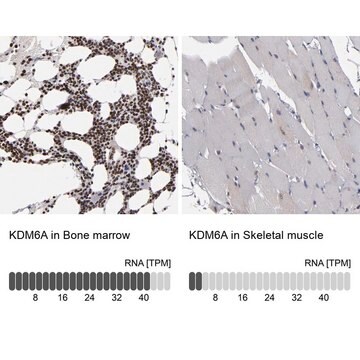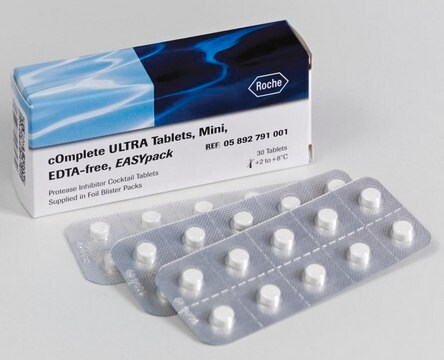ABE1865
Anti-UTX (KDM6A)
from rabbit, purified by affinity chromatography
Synonyme(s) :
Lysine-specific demethylase 6A, Histone demethylase UTX, Ubiquitously-transcribed TPR protein on the X chromosome, Ubiquitously-transcribed X chromosome tetratricopeptide repeat protein
About This Item
ICC
IF
IP
WB
immunocytochemistry: suitable
immunofluorescence: suitable
immunoprecipitation (IP): suitable
western blot: suitable
Produits recommandés
Source biologique
rabbit
Niveau de qualité
Forme d'anticorps
affinity isolated antibody
Type de produit anticorps
primary antibodies
Clone
polyclonal
Produit purifié par
affinity chromatography
Espèces réactives
human, mouse
Technique(s)
ChIP: suitable
immunocytochemistry: suitable
immunofluorescence: suitable
immunoprecipitation (IP): suitable
western blot: suitable
Numéro d'accès NCBI
Numéro d'accès UniProt
Conditions d'expédition
ambient
Modification post-traductionnelle de la cible
unmodified
Informations sur le gène
human ... KDM6A(7403)
Description générale
Ref.:
Lederer, D et al. (2012). Am. J. Hum. Genet. 90, 119-124.
Zha, L et al. (2015). J. Biol. Chem. 290, 25151-25163.
Spécificité
Immunogène
Application
Chromatin Immunoprecipitation (ChIP) Analysis: A representative lot detected a time-dependent UTX (KDM6A) enrichement at the Myogenin and CKm regulatory regions following myogenic differentiation of murine C2C12 myoblasts. shRNA-mediated Six4 knockdown, but not p38 MAPK inhibition, downregulated UTX (KDM6A) recruitment to the Myogenin and CKm loci (Seenundun, S., et al. (2010). EMBO J. 29(8):1401-1411).
Immunocytochemistry Analysis: A representative lot detected UTX (KDM6A) immunoreactivity by indirect immunofluorescence staining of 1% paraformaldehyde-fixed, 0.5% Triton X-100-permeabilized myofibers isolated from mouse extensor digitorum longus (EDL) muscles (Faralli, H., et al. (2016). J. Clin. Invest. 126(4):1555-1565).
Immunofluorescence Analysis: A representative lot detected UTX (KDM6A) immunoreactivity by indirect immunofluorescence staining of 4% paraformaldehyde-fixed, 1% Triton X-100-permeabilized, transverse OCT cryosections sections of mouse tibialis anterior skeletal muscle (Faralli, H., et al. (2016). J. Clin. Invest. 126(4):1555-1565).
Immunoprecipitation Analysis: A representative lot co-immunoprecipitated PTIP and RbBP5 with UTX using embryonic stem cell (ESC) nuclear extracts from wild-type or Utx(KI/KI) mice harboring homozygous demethylase dead Utx mutant gene knock-in. No UTX/PTIP/RbBP5 complex was precipitated from Utx-knockout ESCs (Faralli, H., et al. (2016). J. Clin. Invest. 126(4):1555-1565).
Immunoprecipitation Analysis: A representative lot co-immunoprecipitated Six4 with UTX (KDM6A) using nuclear extract from murine C2C12 myoblasts 24 hrs post myogenic differentiation (Seenundun, S., et al. (2010). EMBO J. 29(8):1401-1411).
Western Blotting Analysis: A representative lot detected UTX4 in myoblast whole cell lysates and embryonic stem cell (ESC) nuclear extracts from wild-type or Utx(KI/KI) mice harboring homozygous demethylase dead Utx mutant gene knock-in, as well as in UTX and MLL4 immunoprecipitates. No UTX target band was detected in Utx-knockout ESCs (Faralli, H., et al. (2016). J. Clin. Invest. 126(4):1555-1565).
Western Blotting Analysis: A representative lot detected UTX (KDM6A) in nuclear extracts from human K562 and murine C2C12 myoblasts (24 hrs post myogenic differentiation), as well as in Six4 immunoprecipitates. shRNA treatment prior to nuclear extract preparation diminished target band detection (Seenundun, S., et al. (2010). EMBO J. 29(8):1401-1411).
Epigenetics & Nuclear Function
Qualité
Western Blotting Analysis: 0.2 µg/mL of this antibody detected UTX (KDM6A) in 10 µg of HeLa nuclear extract.
Description de la cible
Forme physique
Stockage et stabilité
Autres remarques
Clause de non-responsabilité
Vous ne trouvez pas le bon produit ?
Essayez notre Outil de sélection de produits.
Code de la classe de stockage
12 - Non Combustible Liquids
Classe de danger pour l'eau (WGK)
WGK 1
Certificats d'analyse (COA)
Recherchez un Certificats d'analyse (COA) en saisissant le numéro de lot du produit. Les numéros de lot figurent sur l'étiquette du produit après les mots "Lot" ou "Batch".
Déjà en possession de ce produit ?
Retrouvez la documentation relative aux produits que vous avez récemment achetés dans la Bibliothèque de documents.
Notre équipe de scientifiques dispose d'une expérience dans tous les secteurs de la recherche, notamment en sciences de la vie, science des matériaux, synthèse chimique, chromatographie, analyse et dans de nombreux autres domaines..
Contacter notre Service technique







